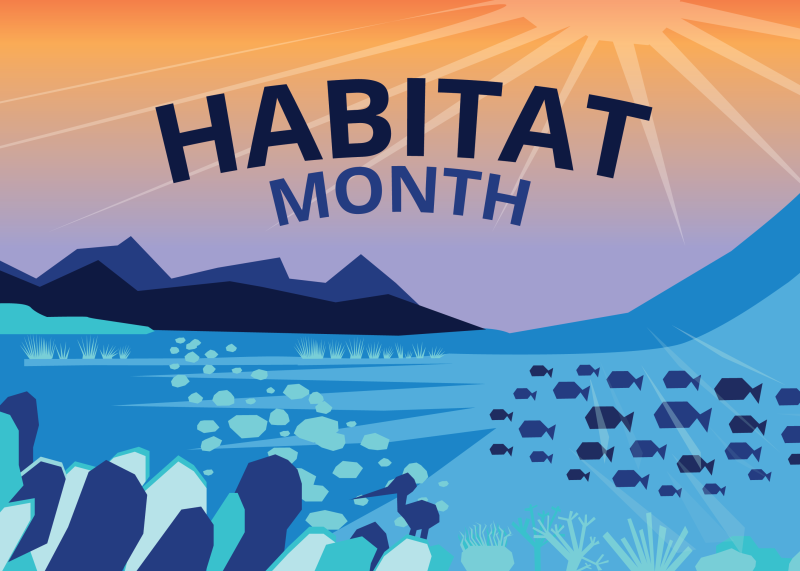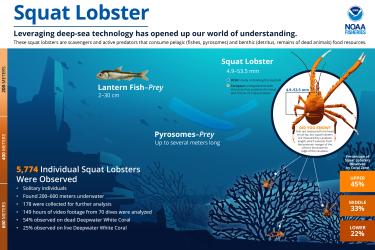We are excited to kick off Habitat Month! All month long, we will share amazing habitat conservation efforts through our website and social media. The theme this year is "Growing Habitat Together.” We will focus on how NOAA Fisheries is working with our partners to make a historic impact to restore coastal habitats and support communities across the country. We are expanding our work, growing new partnerships, and growing more actual habitat.
We are continuing our work to support fisheries and coastal communities through habitat conservation and coastal resilience efforts. This includes:
- Fish passage projects that restore access to healthy habitats for migratory fish
- Habitat restoration projects that support fisheries and protected species while also strengthening the resilience of coastal ecosystems and communities
- Capacity building and on-the-ground restoration projects that advance the coastal habitat restoration priorities of tribes and underserved communities
During July, we will highlight a variety of different habitat conservation projects and products. Follow us here and on Twitter (@NOAAHabitat, #HabitatMonth). Also, be sure to stay up-to-date by becoming a HabitatNews subscriber. Help spread the word about the importance of habitat conservation in making an impact for coastal ecosystems and communities.
Habitat Features
Podcast: Restoring the Klamath River Basin—The Largest Dam Removal Project in the World
How the restoration of the Klamath watershed, the largest dam removal project in the world, will reopen access to habitat for the threatened and endangered native fish of the area.
Listen to the podcast on Restoring the Klamath River Basin
Two Fish Passage Funding Opportunities Now Open, One Focused on Tribes
Through the Bipartisan Infrastructure Law and Inflation Reduction Act, NOAA is seeking proposals for fish passage projects that will reopen migratory pathways and restore access to healthy habitat for fish around the country.
NOAA seeking proposals for fish passage projects
$3.2 Million Recommended for Great Lakes Habitat Restoration
Funding for two ongoing and two new cooperative agreements will support habitat restoration efforts that strengthen Great Lakes fisheries, ecosystems, and communities.
Recommended funding for Great Lakes Habitat Restoration
More Than $910,000 Recommended for Ruth Gates Coral Restoration Innovation Grants Projects
Projects will develop novel restoration and intervention methods to promote resilient coral ecosystems in a changing climate.
Ruth Gates Coral Restoration Innovation Grant Projects
NOAA Funding Supports Chesapeake Bay Watershed Environmental Education
NOAA is recommending nearly $2.62 million for NOAA Chesapeake Bay-Watershed Education and Training projects that support student learning, teacher training, and more.
Funding is part of the Chesapeake Bay-Watershed Education and Training program
Chesapeake Bay Oyster Reef Restoration Acreage Surpasses 2 Square Miles
More than 1,055 football fields of healthy reef habitat now support the ecosystem and the economy.
Chesapeake Bay oyster reef restoration
Stranding Network Partners Successfully Relocate Trapped Mother and Dolphin Calf in Louisiana
Stranding experts monitored the pair for more than a year until the calf was old enough to be moved.
Learn more about the successful relocation
Two NOAA Programs Support Restoration After Coastal Pollution
NOAA is “Growing Habitat Together” through the Damage Assessment, Remediation, and Restoration and the Deepwater Horizon programs.
NOAA’s Deep Sea Coral Research and Technology Program Website
The Deep Sea Coral Research and Technology Program is administered by the Office of Habitat Conservation within NOAA Fisheries. It is the nation’s only federal research program dedicated to increasing scientific understanding of deep-sea coral ecosystems. This work informs critical management decisions about these habitats and the ecosystems they support in every region of the United States and its territories. On this website you can learn more about the Program, explore our regional initiatives, and search and download publications related to our work.
StoryMap: Explore Mesophotic and Deep Benthic Communities Expeditions in the Gulf of Mexico
Learn about expeditions informing restoration of habitats injured in the Deepwater Horizon oil spill.
West Coast Wraps Up Exciting 4-Year Deep-Sea Coral Initiative
The effort has greatly improved our understanding of deep-sea corals and sponges off the coasts of California, Oregon, and Washington, particularly within national marine sanctuaries.
West Coast Deep-Sea Coral Research Initiative
Community Comes Together to Replant a Restored Marsh in North Carolina
Marsh restoration in the Cape Fear River Basin is helping to improve water quality and offer storm protection.
Marsh restoration in the Cape Fear River Basin
Gear Up for the Summer Snapper Season with Return ‘Em Right
Gulf of Mexico offshore anglers: prep for summer reef fish seasons with gear, training, and giveaways to help fish survive.
Learn more about the Return 'Em Right project
Habitat Restoration in the Great Lakes: By the Numbers
NOAA’s habitat restoration work in the Great Lakes strengthens healthy fisheries and ecosystems, benefits local economies, and supports resilient communities.
NOAA's habitat restoration in the Great Lakes
Video: Treasuring the Choptank—Residents and Scientists Envision a Healthier Chesapeake Bay
On Maryland's Eastern Shore, NOAA and partners are conducting science, restoring habitat, and working with community organizations to help residents develop and implement their vision for a healthy Choptank River.
Science and restoration on the Choptank River
Story Map: Commencement Bay
Reinvigorating a critical urban estuary.
Story Map: Tour 30 Restoration Projects Supporting Healthy Habitat and Stronger Communities
This interactive story map highlights 30 projects to celebrate almost 30 years of work by the NOAA Restoration Center and our partners.
















